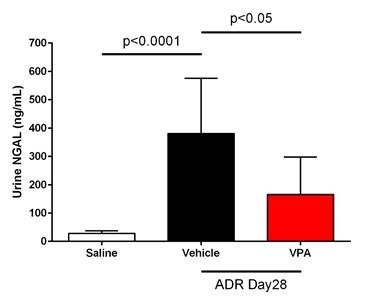Biomarker for kidney damage in Adriamycin model
We would like to introduce a non-invasive biomarkers for kidney disease models.
Urine NGAL levels in ADR model at Day28

Generally, eGFR is calculated using creatinine and is used to diagnose chronic kidney disease (CKD). However, when the effect on the kidney is weak, issues such as slow or no change are observed.
Therefore, there is a need for biomarkers that can accurately and easily measure the effects of CKD on the kidney.
One of these potential markers is neutrophil gelatinase-associated lipocalin (NGAL), a urine and blood biomarker for kidney damage.
NGAL is reported to be useful for diagnosis in FSGS and CKD patients. It also shows a stronger correlation with CKD progression than preexisting diagnostic markers such as proteinuria and serum creatinine [Zhang Q., et al, Am J Med Sci., 2018; Bolignano D., et al, Clin J Am Soc Nephrol., 2009].
After analyzing urine NGAL concentration in the Adriamycin model, significant increase was seen at Day 28 after Adriamycin induction.
In addition, significant decrease was seen VPA group as reference control at Day 28.
You can find more detailed information about the Adriamycin model below.
